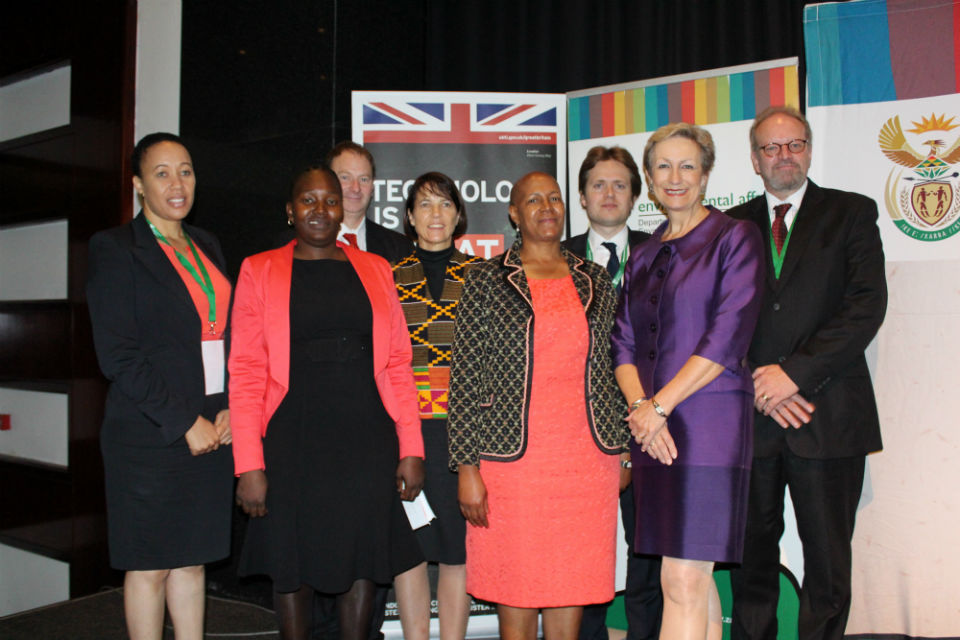South Africa launches its carbon calculator
High Commissioner to South Africa Judith Macgregor speaks at the launch of the South Africa's carbon calculator

Congratulations
It’s a fantastic achievement to publish such a comprehensive and easy to use piece of work. It covers all greenhouse gases and all sectors, and you’ve achieved this in less than one year (quicker than the UK!). This is testament to the hard work of the University of Cape Town, and Deborah Ramalope’s team at the Department of Environmental Affairs.
The UK published its Calculator in 2010. Government is often not used to making that amount of information public – but our experience has been that being open has really helped the level of public debate on how we should meet our target to reduce our greenhouse gas emissions by 80% by 2050. And it has helped our government to become more focused on the big things that really matter.
I know we were slightly nervous about being so transparent – but the 2050 Calculator has actually won quite a lot of awards, even one given by the Queen at Buckingham Palace. And perhaps even more importantly it is something that you have been able to adapt into something useful for South Africa. I know that the UK team at the Department of Energy and Climate Change, would never have imagined back in 2010 that we would be here to launch a South African 2050 Calculator in 2014.
How the UK used its 2050 Calculator
I know that the Department Environmental Affairs has a lot of ideas of how to use your Calculator here, but I just wanted to give you a few examples of how we’ve used the UK version over the past couple of years. As I said the UK launched its Calculator in May 2010, but we are still using it today over 4 years later.
We’ve used it to explore what our stakeholders think government should do in the long term to reduce our greenhouse gas emissions. The tool is so well regarded that it can be used by both Friends of the Earth, and engineering firms. Its strength has been that it allows everyone to put forward their opinion, as long as it is based on things that are technically possible.
We’ve used it to develop 4 official government scenarios for 2050 which we published in 2011 as our strategy for how we will achieve our 80% emissions reduction target. Because the tool is simple to use – it was much easier to discuss how to do this with all the different areas of government that need to agree on a long term plan.
Our press office have used it to engage with journalists on the challenges that the UK faces. And we think that this has improved the level of public debate. (Some journalists have even used it to argue against their colleague’s opinion articles!).
We use it to brief members of parliament in some of the specialist committees in the House of Commons and the House of Lords. The Department of Energy and Climate Change’s Chief Scientist, David Mackay, has given a number of private sessions to MPs to help them understand how it works and how it can help their work.
And we even created a version for school children (and some adults too!) which has been viewed by over 100,000 people. They were able to use it to send in what they think the UK should look like in 2050. 20,000 of them have done that already. Reducing greenhouse gas emissions is a technical and complicated task – but it is important to offer information to the public to explain why government is taking action. (if there is a screen at the launch it would be good to show this live).
We hope that you can have a similar debate in South Africa. The great thing about the Calculator is that it encourages the user to put forward what they think should happen – not just focus on the things that they don’t like.
UK support for South Africa project
We have been delighted to support the South Africa 2050 Calculator project using funds from the UK’s International Climate Fund – which is providing a total of £3.87 billion over five years to help countries adapt to climate change and promote cleaner, greener growth. Whilst this project is not one of the big capital spend projects funded by the ICF, we hope that this sort of knowledge sharing has been useful for your future planning. South Africa is also receiving support from a larger ICF project on Carbon Capture and Storage through a World Bank project.
There are currently 8 other countries working on building their own versions of the 2050 Calculator – including Brazil, Nigeria and Mexico. We are certainly going to be using your example to offer them inspiration and confidence that this is possible – so you’re really in the frontline of this work.
Continuing this partnership
We see this as being very much the beginning of our collaboration on the 2050 Calculator with the DEA. The UK’s experience was that our stakeholders came forward after we launched our version in 2010, with lots of suggestions on how the work could be improved. That’s the beauty of publishing everything online and open source– it enables you to benefit from the knowledge of everyone within your country, not just within government. So we hope we can continue to support you to refine your work. My team and the 2050 Calculator team in the UK’s Department of Energy and Climate Change are on hand to help this happen.
So congratulations again – and we look forward to continue working together to make the South Africa 2050 Calculator a real success.